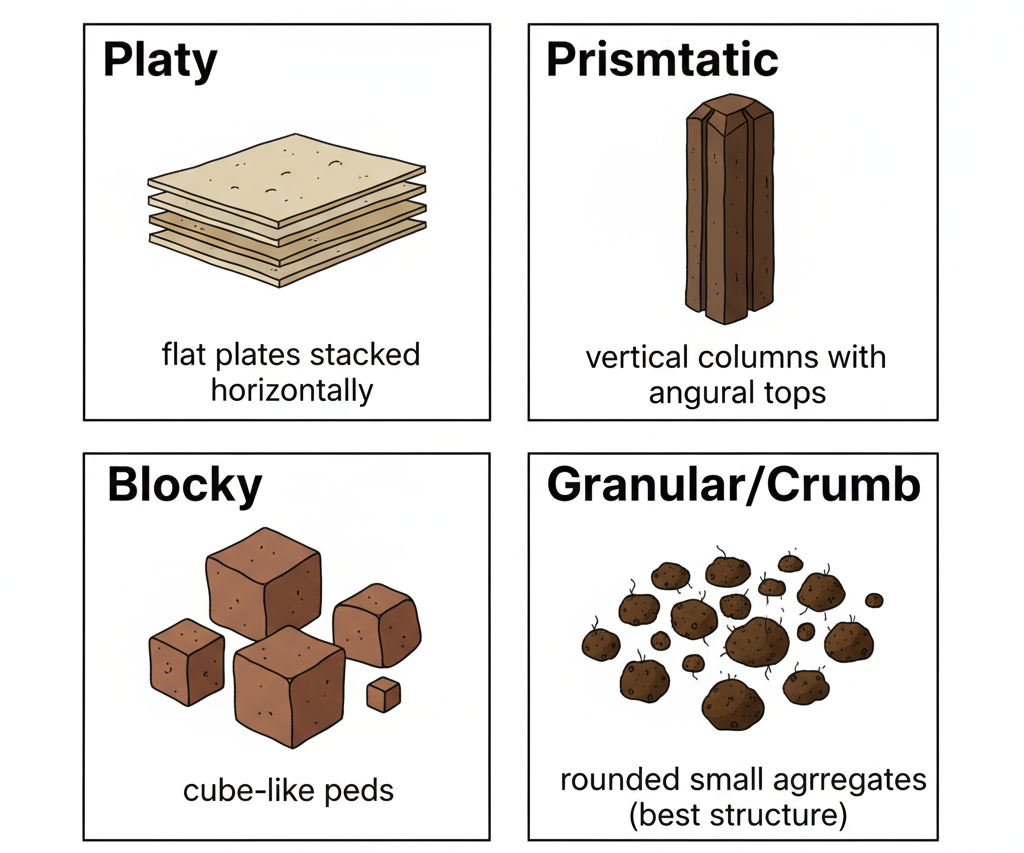Soil structure
- Introduction
- Soil structure is one of the most important physical properties of soil.
- While soil texture refers to particle size, soil structure refers to how those particles are arranged to form aggregates or peds.
- It influences almost all soil functions — aeration, drainage, root growth, water retention, and tillage.
- Definition
Soil structure is the arrangement and organization of primary soil particles (sand, silt, and clay) into secondary units or aggregates (peds) that are separated by planes of weakness.
- Difference Between Soil Texture and Soil Structure
|
Basis |
Soil Texture |
Soil Structure |
|
Definition |
Relative proportion of sand, silt, clay |
Arrangement of particles into aggregates |
|
Changeability |
Permanent property |
Can be changed by management |
|
Determined by |
Particle size |
Organic matter, clay, tillage, biological activity |
|
Examples |
Sandy, loamy, clayey |
Granular, blocky, platy |
|
Affects |
Nutrient and water retention |
Aeration, drainage, tilth |
- Components Responsible for Soil Structure Formation
- Soil Particles – sand, silt, and clay.
- Organic Matter – acts as a cementing agent.
- Clay Colloids – hold soil particles together.
- Microorganisms – produce gums and polysaccharides that stabilize aggregates.
- Ions (Ca²⁺, Mg²⁺) – promote flocculation and aggregation.
- Formation of Soil Structure
The process of soil aggregate (ped) formation is called Pedogenesis of structure or Aggregation.
Steps in Structural Formation:
- Flocculation of particles — fine particles (especially clays) come together by ionic attraction (Ca²⁺ > Mg²⁺ > Na⁺).
- Cementation — binding by organic matter, iron/aluminum oxides, and microbial secretions.
- Stabilization — development of durable aggregates (granular, blocky, etc.).
Note: Excess Na⁺ ions cause dispersion → destroys structure (sodic soils).
- Types (Classifications) of Soil Structure
According to shape and arrangement of peds, soil structures are classified into four main types:
|
Type of Structure |
Shape / Description |
Common in |
Effect on Soil |
|
1. Platy |
Thin, flat plates arranged horizontally; layers look like flakes or sheets |
Surface soils under compaction or poor drainage |
Restricts air, water, and root penetration |
|
2. Prismatic / Columnar |
Vertical pillars or columns, angular tops (prismatic) or rounded tops (columnar) |
Subsoils of arid and semi-arid regions; clay-rich soils |
Moderate permeability; columnar type may indicate sodicity |
|
3. Blocky |
Irregular, cube-like peds with distinct edges |
Subsurface (B horizon) of clay loam soils |
Good root penetration and drainage |
|
4. Granular / Crumb |
Small, rounded aggregates loosely packed |
Surface horizons with high organic matter |
Ideal for plant growth; excellent aeration and tilth |
Diagram Suggestion: “Types of Soil Structure”
A simple labeled sketch should include:
- Platy: flat plates stacked horizontally
- Prismatic: vertical columns with angular tops
- Blocky: cube-like peds
- Granular/Crumb: rounded small aggregates (best structure)

- Grades of Soil Structure
Based on the distinctness of peds, structure is graded as:
|
Grade |
Description |
|
1. Weak |
Poorly formed aggregates; unstable |
|
2. Moderate |
Well-formed, distinct aggregates |
|
3. Strong |
Durable, clearly defined peds; very stable |
- Classes of Soil Structure
Refers to the size of the aggregates.
|
Class |
Size of Peds |
|
Very fine / Fine |
< 1 mm |
|
Medium |
1–5 mm |
|
Coarse |
> 5 mm |
- Structureless Soils
Some soils have no definite structure, where particles are either single-grained or massive.
|
Type |
Description |
Example |
|
Single-grained |
Individual particles not aggregated |
Sandy soils |
|
Massive |
Hard, coherent mass with no peds |
Clayey subsoils or compacted layers |
- Importance of Soil Structure
|
Aspect |
Effect of Good Structure |
|
1. Aeration |
Improves air circulation for roots and microbes |
|
2. Water movement |
Enhances infiltration and drainage |
|
3. Water-holding capacity |
Increases available water storage |
|
4. Root penetration |
Facilitates easy root growth |
|
5. Soil erosion |
Reduces erosion by improving infiltration |
|
6. Cultivation |
Provides good tilth and reduces energy required for tillage |
|
7. Soil fertility |
Improves nutrient availability and microbial activity |
- Management and Improvement of Soil Structure
|
Practice |
Effect / Purpose |
|
Add organic matter (FYM, compost, crop residues) |
Improves aggregation and microbial activity |
|
Use of gypsum or lime |
Promotes flocculation (Ca²⁺ replaces Na⁺) |
|
Avoid excessive tillage |
Prevents compaction and structural breakdown |
|
Adopt crop rotations with legumes |
Adds organic matter and root channels |
|
Maintain proper moisture |
Prevents cracking and slaking |
|
Avoid working on wet soil |
Prevents puddling and compaction |
Relationship Between Soil Texture and Structure
|
Texture |
Typical Structure |
Remarks |
|
Sandy |
Single-grained or weak crumb |
Poor cohesion |
|
Loamy |
Granular / Blocky |
Ideal structure |
|
Clayey |
Blocky / Prismatic |
High plasticity, compact |
- Summary Table
|
Type of Structure |
Shape |
Common in Horizon |
Agricultural Value |
|
Granular / Crumb |
Rounded aggregates |
A horizon (surface) |
Excellent for crops |
|
Blocky |
Cube-like |
B horizon |
Moderate |
|
Prismatic / Columnar |
Vertical pillars |
Subsoils (arid/semi-arid) |
Moderate to poor |
|
Platy |
Thin horizontal plates |
Compact surface soils |
Poor |
|
Massive / Single-grained |
No aggregation |
Hardpans / sands |
Poor |

